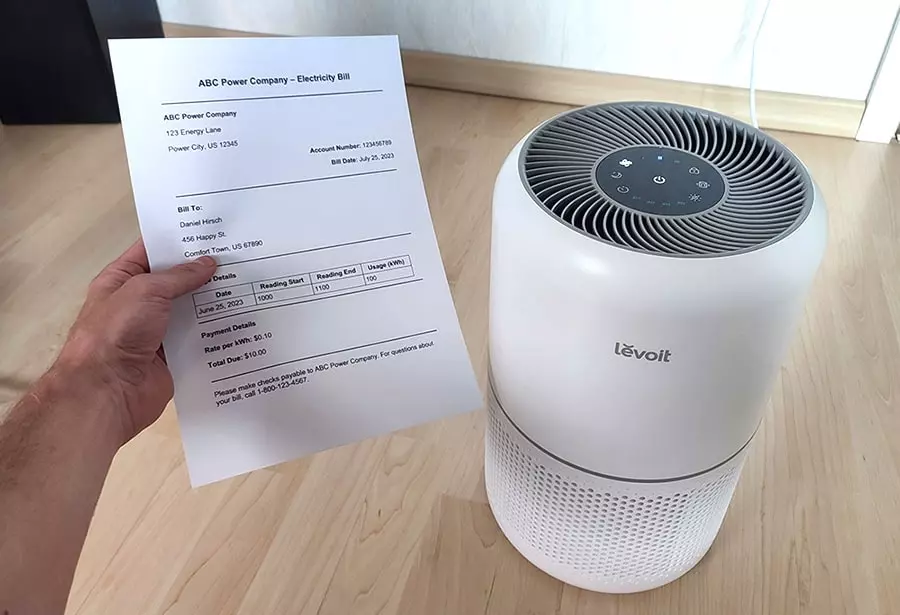How much does an Air Purifier cost to run? I love my air purifier and I’d really like to run it 24/7. But how much would that cost?
In this guide, I am going to answer how much running an air purifier for different durations costs (8 hours, 24 hours, etc.).
After reading the article, you’ll know exactly, how much your air purifier costs to run, why it costs so much (or so little), and how you can reduce the power consumption even further!
Quick answer: An average air purifier costs $15.24 to run per year. However, factoring in replacement filter cost of $35 a year, the total yearly running + maintenance cost is $50.24. You can cut your air purifier’s electricity consumption significantly if you run it on the “Medium” airspeed setting rather than “High”.
Hold on!
This was just the quick answer. Different air purifiers consume different amounts of electricity. And in different states, you have to pay different electricity rates.
So, your personal air purifier running cost can vary. But don’t worry. In the rest of this article, I will guide you through
- air purifier electricity consumption
- electricity costs in different places (and how to know your exact electricity rate)
- and how to calculate how much your air purifier costs you (don’t worry, I already did all the calculations - you can just look up your running cost in a table!)
So, the aim of this article is to give you a thorough understanding of how things are calculated. And if you’re too lazy to calculate things on your own, I will just point you to your personalized result!
How much Power does an Air Purifier consume?
Different electric devices consume different amounts of power. So, before we can calculate anything, we first have to find out how much power a typical air purifier consumes.
My favorite, and, by far the #1 best-selling air purifier is the Levoit Core 300S (click here to view my review). It consumes 33W.
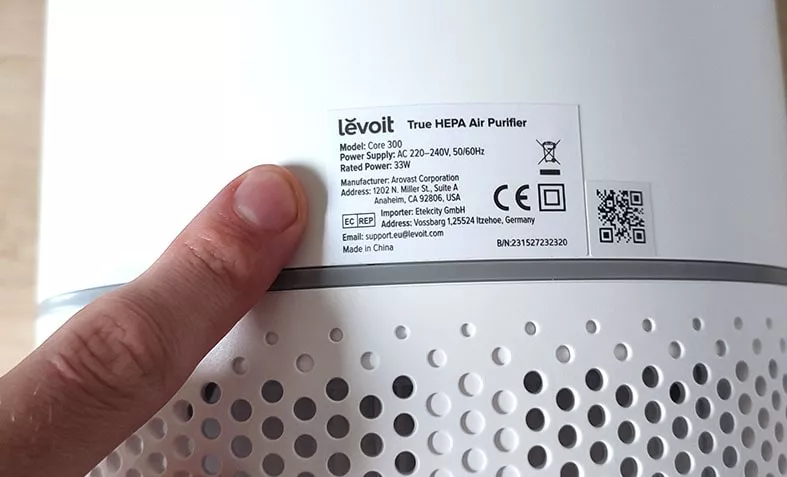 The power rating of an air purifier is easy to spot on the technical-details label. There it says “Rated Power: 33W”
The power rating of an air purifier is easy to spot on the technical-details label. There it says “Rated Power: 33W”
Let’s have a look at different air purifiers and their wattages:
| Air Purifier Model | How much power does it consume? (in Watts) | Room size covered (in square feet) |
|---|---|---|
| Levoit Core Mini | 7 Watts | 356 sq. ft. |
| Levoit Core 300S | 33 Watts | 1,095 sq. ft. |
| Levoit Core 600S | 49 Watts | 3,175 sq. ft. |
| Germ Guardian | 55 Watts | 743 sq. ft. |
| Dyson Pure Cool TP01 | 56 Watts | 1,500 sq. ft. |
By the way: Finding the wattages of Dyson air purifiers was really hard. They are not listed anywhere and I had to dig the internet for their technical specification.
I guess that’s because Dyson advertises their energy efficiency so much. But when you measure wattages, you see that they are no better than other brands.
Levoit and Germ Guardian happily list their wattages everywhere for comparison.
As you can see, different air purifiers consume different wattages.
I also added a column that lists the room sizes covered by the different air purifiers. And very surprisingly to me, it appears that wattage is not directly linked to room size covered.
While Levoit Core air purifiers cover more area, the stronger they get, the Germ Guardian and the Dyson Pure both consume more power than the other purifiers, but cover less area.
( I’d say that is a thumbs-up for Levoit )
A typical air purifier consumes 30 - 40 Watts of power. Small models can consume as little as 7 Watts, while larger models consume 50W or more.
Power usage by filter type
All five air purifiers in the list above use HEPA 13 filters. This means that different filters don’t explain their different electricity usage.
But technically, different filters would cause different power consumption. A filter, in principle, resists airflow and only allows extremely fine particles to pass.
So, the finer your air filter works, the harder it usually is for air to pass through it. Which has an impact on power consumption.
Since almost all air purifiers on the market use standardized HEPA 13 filters, the filters don’t explain the differing power consumption.
But if you ever switch out the HEPA filter for a less fine-grained one, you should see a drop in power usage.
 Here’s a typical air purifier filter. Different filters allow for different airspeeds!
Here’s a typical air purifier filter. Different filters allow for different airspeeds!
How Does Fan Speed Affect Power Consumption?
Another factor that impacts the power consumption is, of course, the fan speed. So, the more air your purifier forces through the filter, the more power it consumes.
One nice user (named Melody Reed) measured the power consumption of his Levoit Core 300S air purifier using a Kilowatt-meter and put the results in their amazon review. (Thank you!)
| Airflow setting | Power consumption (in Watts) |
|---|---|
| Low | 27 Watts |
| Medium | 32 Watts |
| High | 47 Watts |
| Night mode | 10 Watts |
So, the higher the setting, the more power your air purifier consumes. Makes sense.
And, interestingly, on night mode an air purifier consumes just about a third of the power of “Low” mode. I wonder if night mode even collects any significant dust.
One more important finding is that on “High”, the Levoit Core 300S consumes 47 Watts, which is more than the 33 Watts usually specified for it.
Apparently, the wattages of some air purifiers are just average values. And if you run your air purifier at “High” speed, it consumes significantly more.
In this example, an air purifier consumes roughly 42.4% more power when you run it on the highest setting as compared to the medium setting.
That’s quite a jump!
( My calculation here was 47 Watts ÷ 33 Watts ≈ 1.4242, which corresponds to a 42.4% increase)
If you flip the reasoning around, this means you can save 42.4% on your air purifier’s electricity bill by reducing the airflow setting from “High” to “Medium”.
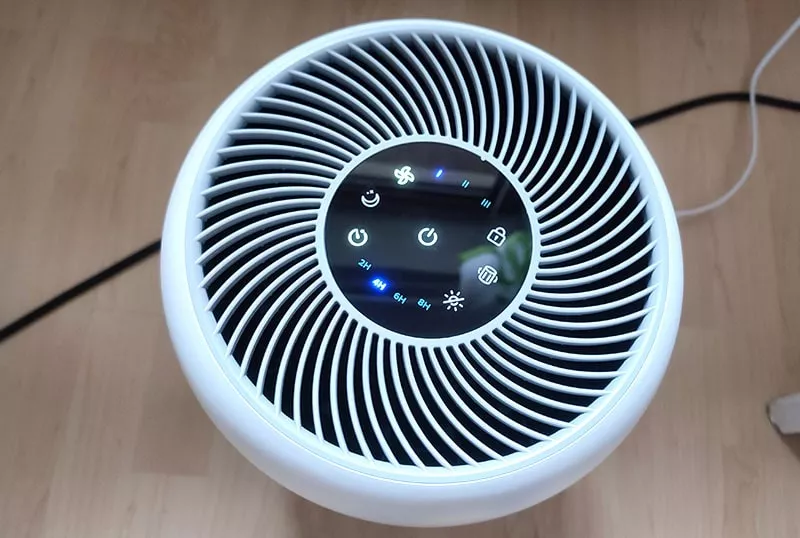 On the Levoit Core 300 air purifier, you have 3 air speeds to choose from, plus night mode. I am running on air speed 1 right now.
On the Levoit Core 300 air purifier, you have 3 air speeds to choose from, plus night mode. I am running on air speed 1 right now.
Electricity consumption of air purifiers by running time
So far we’ve checked the power consumption of air purifiers. Now, with that power consumption, you can find out how much electric energy your air purifier consumes.
For anyone who’s not familiar with the difference between power and energy:
Power consumption is the rate at which a device consumes energy. For example, an air purifier consumes 33 Watts of power. That’s similar to the horsepower in a car. You don’t pay for horsepower but for gallons of fuel consumed. Similarly, you don’t pay for power, but for total electric energy consumed.
The longer you run your air purifier, the more energy it consumes.
Electric energy consumed (in Watt-hours) = Power (in Watt) × Time (in hours)
After 1 hour, a 33W air purifier, therefore, consumes
33 Watts × 1 hour = 33 Watt-hours
A thousand Watt-hours (Wh) make up one Kilowatt-hour (kWh). So, you can divide the result by 1,000 to get the Kilowatt-hours consumed:
Kilowatt-hours = Watt-hours ÷ 1000
On your electricity bill, you are charged for the Kilowatt-hours consumed. So, that’s why it’s useful to convert from Wh to kWh. For example:
33 Wh = 0.033 kWh
So, let’s create a complete table of air purifier electricity consumption by running time:
The left column specifies the power consumption of the air purifier. And each column to the right lists the total electricity consumption (in Watt-hours) after running it for 1 hour, 8 hours, or 24 hours.
| Electricity consumption by running time | 1h | 8h | 24h |
|---|---|---|---|
| 10 W | 0.010 kWh | 0.080 kWh | 0.240 kWh |
| 20 W | 0.020 kWh | 0.160 kWh | 0.480 kWh |
| 30 W | 0.030 kWh | 0.240 kWh | 0.720 kWh |
| 40 W | 0.040 kWh | 0.320 kWh | 0.960 kWh |
| 50 W | 0.050 kWh | 0.400 kWh | 1.200 kWh |
| 60 W | 0.060 kWh | 0.480 kWh | 1.440 kWh |
As you can see, the more power your air purifier consumes, and the longer you run it, the higher your total electricity consumption.
Since you are paying for electricity by the Kilowatt-hour, let’s have a look at how much electricity costs next.
How Much Does Electricity Cost?
Electricity prices vary a lot within the US. Here’s a table with the latest US-wide electricity rates ( source):
| State | Electricity rate (in USD Cents per kWh) |
|---|---|
| Alabama | 14.51 |
| Alaska | 24.86 |
| Arizona | 14.3 |
| Arkansas | 12.31 |
| California | 29.78 |
| Colorado | 14.37 |
| Connecticut | 31.32 |
| Delaware | 16.65 |
| District of Columbia | 17.08 |
| Florida | 15.22 |
| Georgia | 14 |
| Hawaii | 42.26 |
| Idaho | 10.79 |
| Illinois | 17.86 |
| Indiana | 15.12 |
| Iowa | 14.18 |
| Kansas | 14.09 |
| Kentucky | 12.53 |
| Louisiana | 11.69 |
| Maine | 29.26 |
| Maryland | 16.08 |
| Massachusetts | 29.01 |
| Michigan | 18.56 |
| Minnesota | 15.17 |
| Mississippi | 14.09 |
| Missouri | 12.46 |
| Montana | 12.82 |
| Nebraska | 11.88 |
| Nevada | 17.43 |
| New Hampshire | 30.67 |
| New Jersey | 17.18 |
| New Mexico | 13.3 |
| New York | 20.47 |
| North Carolina | 13.22 |
| North Dakota | 11.7 |
| Ohio | 15.49 |
| Oklahoma | 11.83 |
| Oregon | 12.95 |
| Pennsylvania | 18.26 |
| Rhode Island | 26.92 |
| South Carolina | 14.38 |
| South Dakota | 12.99 |
| Tennessee | 12.34 |
| Texas | 14.49 |
| Utah | 10.85 |
| Vermont | 21.03 |
| Virginia | 15.27 |
| Washington | 11.18 |
| West Virginia | 14.63 |
| Wisconsin | 17.33 |
| Wyoming | 11.93 |
| U.S. Total | 16.14 |
The US average electricity rate is currently about $0.16 per kWh.
But, as you can see, the rate varies a lot from around $0.10 in a lot of states (Mississippi, Washington, Tennessee, and many more) up to >$0.3 in New Hampshire and Connecticut.
So, please look up the electricity rate in your state and note it somewhere!
I’ll create a table later on where you can look up your air purifier’s electricity cost based on where you are.
Or alternatively, you can do your own full calculation and factor in your exact electricity rate, running time, and air purifier wattage.
To get your exact electricity rate, you can check your latest electricity bill. Here’s where to lookup your electricity rate:
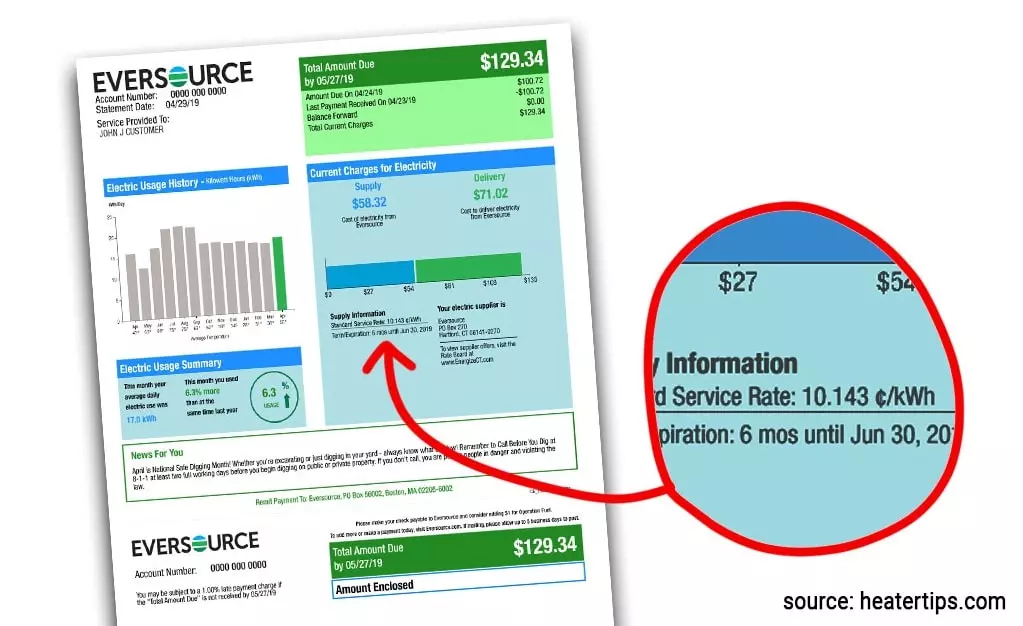 Sample electricity bill and where to lookup your electricity rate - bill layouts differ by provider, but you should know what you’re looking for now!
Sample electricity bill and where to lookup your electricity rate - bill layouts differ by provider, but you should know what you’re looking for now!
How Much Does an Air Purifier Cost to Run?
Now you know everything to calculate your air purifier running cost with absolute precision.
So, first, let me layout the formula you can use.
( If you hate maths, you can skip to the table down below to see the running cost of a typical air purifier. )
The formula for calculating running costs is straightforward:
Running Cost = Electricity Rate (in $ per kWh) x Running Time (in hours) x Power Consumption (in Watts) ÷ 1,000
If you want to calculate your personal air purifier running cost you need:
- your air purifier’s wattage: you can find it on a label on the air purifier
- your personal electricity rate: either use the average value for your state from the table in the previous section, or look it up in your last electricity bill
- the running time: use 1 hour to find out the hourly running cost of your air purifier, or use 24 hours to calculate a full day, etc.
I did all the calculations so you don’t have to!
Here’s the average air purifier running cost per US state (for a regular 33 Watts air purifier):
| States | Hourly running cost for typical 33W air purifier |
|---|---|
| Alabama | 0.48 cents |
| Alaska | 0.82 cents |
| Arizona | 0.47 cents |
| Arkansas | 0.41 cents |
| California | 0.98 cents |
| Colorado | 0.47 cents |
| Connecticut | 1.03 cents |
| Delaware | 0.55 cents |
| District of Columbia | 0.56 cents |
| Florida | 0.50 cents |
| Georgia | 0.46 cents |
| Hawaii | 1.39 cents |
| Idaho | 0.36 cents |
| Illinois | 0.59 cents |
| Indiana | 0.50 cents |
| Iowa | 0.47 cents |
| Kansas | 0.46 cents |
| Kentucky | 0.41 cents |
| Louisiana | 0.39 cents |
| Maine | 0.97 cents |
| Maryland | 0.53 cents |
| Massachusetts | 0.96 cents |
| Michigan | 0.61 cents |
| Minnesota | 0.50 cents |
| Mississippi | 0.46 cents |
| Missouri | 0.41 cents |
| Montana | 0.42 cents |
| Nebraska | 0.39 cents |
| Nevada | 0.58 cents |
| New Hampshire | 1.01 cents |
| New Jersey | 0.57 cents |
| New Mexico | 0.44 cents |
| New York | 0.68 cents |
| North Carolina | 0.44 cents |
| North Dakota | 0.39 cents |
| Ohio | 0.51 cents |
| Oklahoma | 0.39 cents |
| Oregon | 0.43 cents |
| Pennsylvania | 0.60 cents |
| Rhode Island | 0.89 cents |
| South Carolina | 0.47 cents |
| South Dakota | 0.43 cents |
| Tennessee | 0.41 cents |
| Texas | 0.48 cents |
| Utah | 0.36 cents |
| Vermont | 0.69 cents |
| Virginia | 0.50 cents |
| Washington | 0.37 cents |
| West Virginia | 0.48 cents |
| Wisconsin | 0.57 cents |
| Wyoming | 0.39 cents |
| U.S. Total | 0.53 cents |
As you can see, air purifiers are incredibly cheap to run. In most states, you don’t even pay a cent per hour!
So, let’s have a look (based on the US average electricity rate) how much running an air purifier costs for longer time periods:
| Running time | Average 33W air purifier running cost |
|---|---|
| 1 hour | $0.01 |
| 8 hours | $0.04 |
| 24 hours | $0.13 |
| 30 days (8 hours per day) | $1.27 |
| 30 days (24 hours per day) | $3.80 |
Even if you run your air purifier 24/7, it costs just $3.80 per month.
Factoring in air purifier maintenance cost (Replacing filters)
The actual running cost of an air purifier is not just its electricity consumption. Much more significant expenses are the initial buying cost of an air purifier and getting replacement filters.
Depending on the model, buying a new air purifier costs anywhere between $50 - $200. And getting good replacement filters also costs you $20 - $50.
So, the true running cost of an air purifier is:
Air purifier running cost = Initial purchasing price + Replacement air filters + Electric running cost
where the initial purchase price and replacement filters make up the majority of the expenses.
For the running cost, however, we should ignore the purchasing price and just look at the electricity cost and filter replacement cost.
True air purifier running cost
The true running cost (after your initial air purifier purchase) is your maintenance cost + electricity cost.
Here’s an example:
At an average electricity rate, you use an average 33W air purifier. Every year, you spend $35 for a set of 2 replacement filters.
If you run your air purifier for 8 hours a day, this means you pay:
$1.27 electricity cost per month × 12 months a year + 35$ a year for filters = $50.24 per year
The total yearly running and maintenance cost of an average air purifier is $50.24 per year.
At $35, the maintenance cost makes up almost 70% of the total expenses.
How to minimize Air Purifier Running Cost
Let’s have a quick look at how to minimize electricity usage and maintenance cost of an air purifier.
How to minimize electricity usage
Actually, you don’t need to minimize your air purifier’s electric running cost. In most states, an air purifier costs less than a cent to run per hour.
Looking strictly at electricity consumption, the only thing you can do is to run your air purifier on moderate airflow settings.
As you’ve seen in a previous section, the “High” airflow setting consumes 42% more electricity than the “Medium” setting.
So, if you really want to save a dollar or two per month, you should reduce your airflow setting.
Reduce maintenance and replacement cost
You can’t do much about the purchasing price of an air purifier. But what you can do is to reduce the frequency at which you buy new air purifiers.
The longer your air purifier’s lifetime, the lower your running cost is per year. You can only maximize lifetime by
- getting a high-quality air purifier upfront (such as the Levoit Core series - click to read my review)
- getting good quality filters such as these HEPA 13 filters (click here to view them on amazon)
Also, you can extend the lifetime of your filters by not replacing them every time they are full.
Every once in a while, instead of replacing filters, brush the dust off with a soft and dry toothbrush.
Unfortunately, you can’t wash HEPA filters. I think some people do, but I am sure this breaks the air purification feature of your air purifier. It might still collect dust, but it won’t collect smaller microparticles after washing.
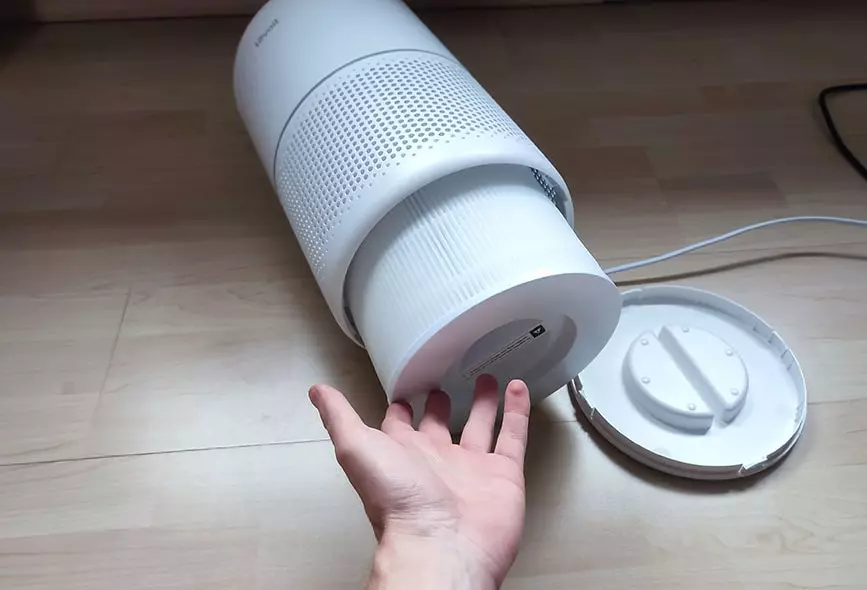 Replacing air purifier filters is incredibly easy. Just open the bottom part, and put in the new filter!
Replacing air purifier filters is incredibly easy. Just open the bottom part, and put in the new filter!
Conclusion
Air purifiers are very cheap to run, looking strictly at electricity cost. If you factor in the maintenance cost of replacing HEPA filters regularly, you get a completely different result.
Filter replacements make up roughly 70% of an air purifiers maintenance cost.
But since electricity is so cheap, I wouldn’t save on filters. The filters are the core component of your air purifier.
They do all the work.
So, get good filters regularly. And don’t worry about electricity expenses - they are almost negligible.
I hope this article was helpful!
